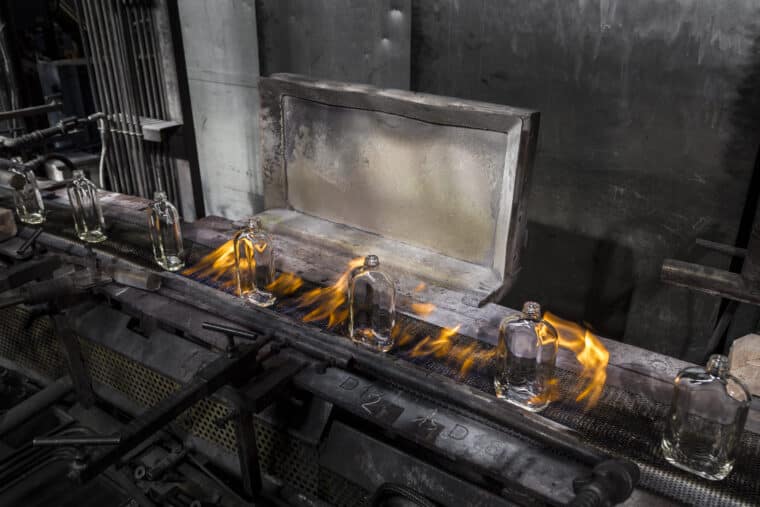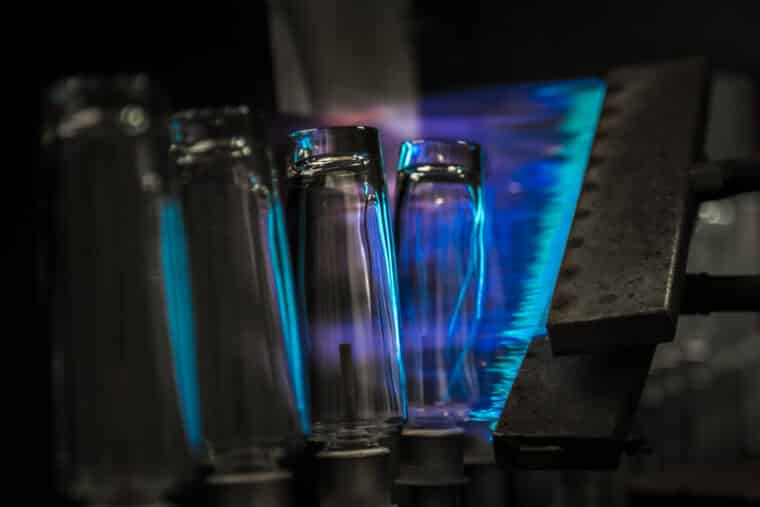How Glass Valley became the world’s luxury packaging leader
Our latest Q&A session followed a story of premium glass craftsmanship from its 19th century roots in France’s Bresle Valley to what Glass Valley represents today – a world-leading packaging centre, responsible for over 70% of the world’s luxury glass bottle production for perfume, cosmetics and pharmaceuticals.
Our special guests Jean-Marc Arrambourg (Chairman and CEO of Saverglass Group, and member of both La Glass Vallée and FEVE) and Stéphane Franconville (President of MG Group France, and Vice President of La Glass Vallée) joined to retrace Glass Valley’s journey to success, as well as how it remains just as committed to a vision of sustainability as it is to respecting its heritage. The session was moderated by Adeline Farrelly (Secretary General of FEVE).
The evolution of the Glass Valley
Evidence of a glass industry in the Bresle Valley can be traced all the way back to the Middle Ages, when glassmakers settled in the forest and began using its resources to produce glassware and flat glass, notably windows and stained glass for fine homes and churches.
As a passion for perfumery developed among the Parisian bourgeoisie, there was a shift towards luxury bottles that stood for quality, style and the latest in fashion. Brands we know and love today, such as Guerlain, began collaborating with local glassmakers on unique designs, leading to the creation of the Paris–Le Treport railway line to transport glassware to city centres.
Today, Glass Valley is the world’s leading producer of luxury packaging, representing more than 70% of the world’s production of glass bottles for the perfume, spirits, cosmetics, and pharmaceutical industries. With over 60 companies and 10,000 specialised employees working in close proximity, Glass Valley has become a unique industrial hub that offers a wide range of traditional products that exemplify the best of ‘Made in France’. It brings together a network of know-how and regroups specialised companies at all stages of glass packaging production.
“The skills and expertise of Glass Valley’s members make it a sort of one-stop-shop capable of offering some of the world’s biggest brands in perfumery, cosmetics, and spirits with a wide range of traditional products – all made in France” – Stéphane Franconville
Glass helps meet quality criteria for luxury products
Glass is an exceptional material for luxury products due to its unique properties. Why?
- As an inert material, glass ensures optimal preservation of its content, while its longer shelf life makes it ideal for storing valuable cellar wines and spirits.
- Its recyclability, reusability, and versatility in terms of shapes and design makes it a popular choice in the perfumery industry, as it allows for unique branding and differentiation that builds brands.
- The transparency and purity of glass enhances the appearance of products, highlighting their true colours and characteristics and adding to the iconic silhouette of many collections.
“Compared to other packaging materials, it’s right to say that glass is the only one that combines all these advantages.” – Jean-Marc Arrambourg
How being a ‘hub’ advanced glass packaging innovation
Glass Valley’s rise to a world-leading hub comes down to two key factors: proximity and shared know-how.
Glass Valley represents more than 60 interconnected companies from all levels of the value chain, all operating in close proximity. This allows them to offer their expertise in all stages of production, from model makers to decorators to manufacturers. Glass Valley also counts on complementary companies, such as those in the transport and storage industry, to deliver finished high-end and luxury glass packaging. Together, these elements give their members the capacity of sharing their know-how on innovation, sustainability and quality with partnering brands.
“[Glass Valley] is a centre of excellence for the most complicated and high-quality packaging. The proximity enables co-innovation between the suppliers and the customers, and we offer that to the market.” – Stéphane Franconville
Current challenges in the luxury industry
Today’s luxury glass is facing significant challenges as consumers, and in turn customers, become increasingly aware of the sustainability footprint of their preferred products. The biggest challenge is balancing regulatory and environmental constraints with innovation and customer support. To address these issues, the industry is working on various weight reduction, recycling, and decarbonisation initiatives.
In turn, Glass Valley is working on creating sustainable glass packaging solutions, by following three principles of customer proximity, collaboration, and , as well as 5 R&D principles:
- Reduce: through initiatives to reduce the weight of glass while maintaining its identity
- Reuse: looking for new reusable glass packaging solutions for perfume bottles
- Recycle: increasing collection of glass throughout the value chain
- Replace: by advancing the “glassification” of luxury packaging products to the detriment of other packaging materials
- Disrupt: providing disruptive solutions to customers and premium brands
Glassmakers must balance environmental constraints with innovation to continue supporting customers while reducing their environmental footprint. Finally, to push initiatives forward that address future challenges, Glass Valley provides in-house 360-degree training with skilled trainers to prepare the next generation of workers to make a positive impact on the industry.
“We see this period as a step change – we need to be agile, flexible, cooperative as much as we can. We’re finding solutions for the industry that will ultimately provide solutions to the market and to customers.” – Jean-Marc Arrambourg
Bringing the Glass Industry 4.0 to life
The glass industry is committed to addressing environmental challenges and has set ambitious decarbonisation objectives that demonstrate its commitment to sustainability. In turn, Glass Valley will continue to strive for sustainable development through sharing its members’ progress, with a clear path to a achieve a more climate-neutral, circular and fit for the future glass packaging.
‘Glass Industry 4.0’ focuses on using technology to enhance expertise in hollow glass, where Industry 4.0 technologies, such as machine learning, are already improving production quality and customer satisfaction. Digital simulation and measurement systems, along with industrial data analysis, help improve process optimization and quality control, as well as reduce CO2 emissions. Human expertise and technology integration ensure success in the premium market.
These initiatives, and others like it across the glass industry, are proof that Glass Valley is building on its combination of historical expertise and modern advancements, creating sustainable solutions while providing training and support to the next generation of workers.
It is this legacy of innovation in glass craftsmanship – along with the exceptional properties of glass as a packaging material, and collaboration from an interconnected network of companies from all levels of the value chain – that have seen Glass Valley become a world leader in luxury packaging. And it is this same legacy that will see them pave the way for the packaging that we rely on in the future.
***
Did you learn anything about the Glass Valley’s history and evolution? Do you think they are advancing the glass industry? Head over to LinkedIn and let us know!
To keep up to date with the latest trends in the glass industry or our upcoming Q&As, don’t forget to follow our LinkedIn Account.
What is the Glass Hallmark?
The Glass Hallmark represents the ability of the container glass on which the mark is put to be recycled and to optimally preserve the content as a result of its inert nature. The Glass Hallmark does not express or claim any other product-related characteristic. It is not and official certification stamp. More specifically, the Glass Hallmark does not constitute any other environmental claim implying in any way e.g., that the glass container concerned contains a minimum percentage of recycled glass or it is effectively recycled at the end of its life. For more information, please see www.glasshallmark.com.






